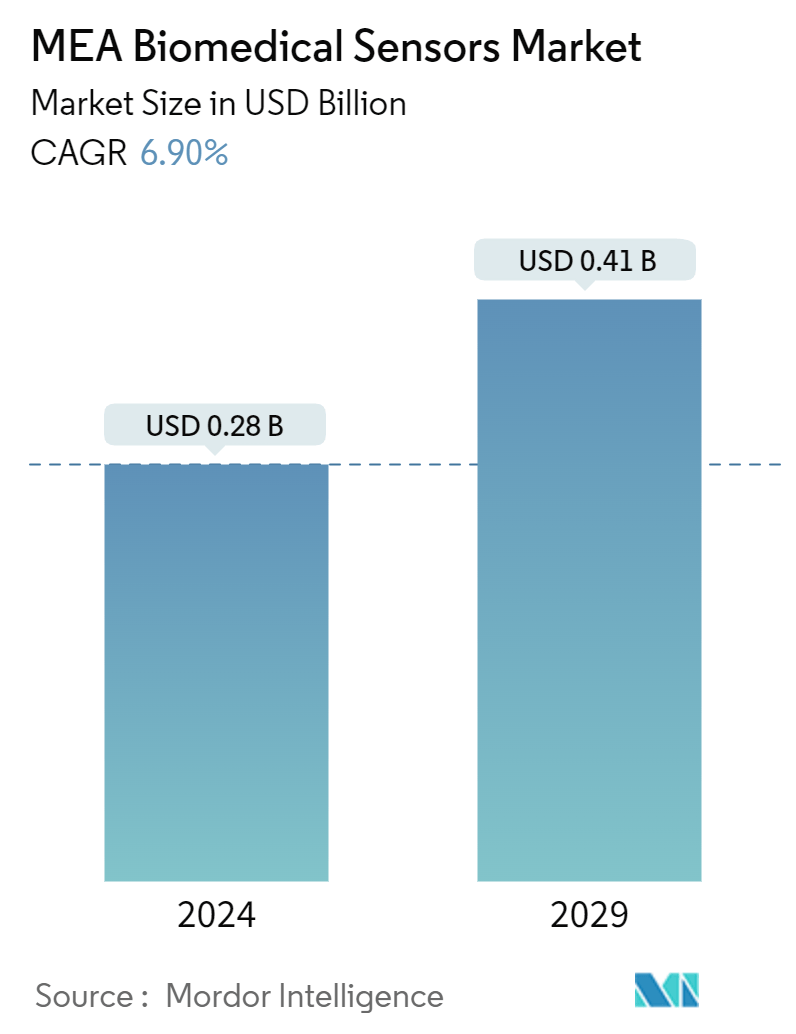Market Size of MEA Biomedical Sensors Industry

| Study Period | 2019 - 2029 |
| Base Year For Estimation | 2023 |
| Market Size (2024) | USD 0.28 Billion |
| Market Size (2029) | USD 0.41 Billion |
| CAGR (2024 - 2029) | 6.90 % |
| Market Concentration | Low |
Major Players
*Disclaimer: Major Players sorted in no particular order |
MEA Biomedical Sensors Market Analysis
The MEA Biomedical Sensors Market size is estimated at USD 0.28 billion in 2024, and is expected to reach USD 0.41 billion by 2029, growing at a CAGR of 6.90% during the forecast period (2024-2029).
Biomedical sensors are made to send out alerts when they spot irregular readings, check for toxic substances in the blood, or infiltrate drugs right into the circulatory system. Investments in creating sensors with these characteristics are vital drivers of the market studied.
- The biomedical sensors market is driven by the expanded demand in hazardous environments, utilization in situations resulting from natural disasters, augmented demand in the healthcare sector for diabetic and heart patients, and implanted monitoring of the patients. Technological advancements have made it possible to build biomedical sensors using nano and microtechnology, making them small, robust, smart, and cost-effective. The early detection of irregularities in the health status of the patients will contribute to a better quality of life.
- Antimicrobial resistance, poor lifestyles, alcohol consumption, and smoking contribute to the increased prevalence of lifestyle-related disorders, including diabetes. According to IDF Diabetes Atlas, 1 in 6 adults (73 million) live with diabetes in the Middle East and North Africa. Furthermore, the number of adults with diabetes is predicted to reach 95 million by 2030 and 136 million by 2045. As a result, the requirement for biomedical sensors for routine health monitoring is growing.
- The growing awareness concerning healthcare has increased the need for sensor technologies and monitoring appliances that can sense and deliver feedback to users about their health status for increased safety, which may further drive the growth of the market studied.
- Even though biomedical sensors play a significant role in life-saving situations, they face specific challenges, such as patient safety and comfort due to strong electromagnetic fields, transferring energy from external to inner parts with high efficiency and increased data rates, limited computation and data storage, and ultra-low energy consumption.
- The Russia-Ukraine War is impacting the supply chain of semiconductors and electronic components, being a significant supplier of raw materials for producing semiconductors and electronic components, including various sensors. The dispute has disrupted the supply chain, causing shortages and price increases for these materials, impacting biomedical sensor manufacturers and potentially leading to higher costs for end users.
MEA Biomedical Sensors Industry Segmentation
Biomedical sensors are special electronic devices that transduce biomedical signals into easily measurable electric signals. Biomedical sensors are critical components in various medical diagnostic instruments and equipment.
The biomedical sensors market in the Middle East and Africa is segmented by type (wired, wireless), sensor type (temperature, pressure, image sensor, biochemical, inertial sensor, motion sensor, and electrocardiogram), industry (pharmaceutical and healthcare), and country (Saudi Arabia, South Africa, and the United Arab Emirates). The report offers market forecasts and size in value (USD) for all the above segments.
| By Type | |
| Wired | |
| Wireless |
| By Sensor Type | |
| Temperature | |
| Pressure | |
| Image Sensors | |
| Biochemical | |
| Inertial Sensors | |
| Motion Sensors | |
| Electrocardiogram (ECG) |
| By Industry | |
| Pharmaceutical | |
| Healthcare |
| By Country | |
| Saudi Arabia | |
| South Africa | |
| United Arab Emirates |
MEA Biomedical Sensors Market Size Summary
The Middle East and Africa biomedical sensors market is poised for significant growth, driven by increasing demand for advanced healthcare solutions and the integration of technology in medical devices. Biomedical sensors, which play a crucial role in monitoring health conditions and delivering real-time data, are becoming increasingly essential due to the rising prevalence of lifestyle-related diseases such as diabetes and hypertension. The market is characterized by the adoption of nano and microtechnology, making sensors more compact, efficient, and cost-effective. This technological advancement is further fueled by the growing awareness of health monitoring and the need for early detection of health irregularities, which contribute to improved quality of life. The market's expansion is also supported by the increasing focus on primary and preventative healthcare, particularly in regions like Saudi Arabia, where significant investments are being made to enhance healthcare infrastructure and services.
Despite the promising growth prospects, the biomedical sensors market faces challenges such as supply chain disruptions due to geopolitical tensions, like the Russia-Ukraine war, which affects the availability and cost of essential components. Additionally, issues related to patient safety and comfort, as well as the need for efficient energy consumption and data management, continue to pose challenges. However, the market is witnessing a surge in interest towards wearable medical devices, which offer continuous monitoring of vital signs and are gaining traction in both consumer and professional healthcare settings. The presence of major global players and strategic partnerships further intensifies the competitive landscape, with companies like NXP Semiconductors, GE HealthCare Technologies, and Medtronic leading the charge in innovation and market expansion. As the demand for personalized and remote patient monitoring solutions grows, the biomedical sensors market in the Middle East and Africa is expected to continue its upward trajectory, supported by technological advancements and increasing healthcare investments.
MEA Biomedical Sensors Market Size - Table of Contents
-
1. MARKET INSIGHTS
-
1.1 Market Overview
-
1.2 Industry Attractiveness - Porter's Five Forces Analysis
-
1.2.1 Threat of New Entrants
-
1.2.2 Bargaining Power of Buyers
-
1.2.3 Bargaining Power of Suppliers
-
1.2.4 Threat of Substitute Products
-
1.2.5 Intensity of Competitive Rivalry
-
-
1.3 Supply Chain Analysis
-
1.4 Impact of Macroeconomic Trends on the Market
-
-
2. MARKET SEGMENTATION
-
2.1 By Type
-
2.1.1 Wired
-
2.1.2 Wireless
-
-
2.2 By Sensor Type
-
2.2.1 Temperature
-
2.2.2 Pressure
-
2.2.3 Image Sensors
-
2.2.4 Biochemical
-
2.2.5 Inertial Sensors
-
2.2.6 Motion Sensors
-
2.2.7 Electrocardiogram (ECG)
-
-
2.3 By Industry
-
2.3.1 Pharmaceutical
-
2.3.2 Healthcare
-
-
2.4 By Country
-
2.4.1 Saudi Arabia
-
2.4.2 South Africa
-
2.4.3 United Arab Emirates
-
-
MEA Biomedical Sensors Market Size FAQs
How big is the MEA Biomedical Sensors Market?
The MEA Biomedical Sensors Market size is expected to reach USD 0.28 billion in 2024 and grow at a CAGR of 6.90% to reach USD 0.41 billion by 2029.
What is the current MEA Biomedical Sensors Market size?
In 2024, the MEA Biomedical Sensors Market size is expected to reach USD 0.28 billion.

